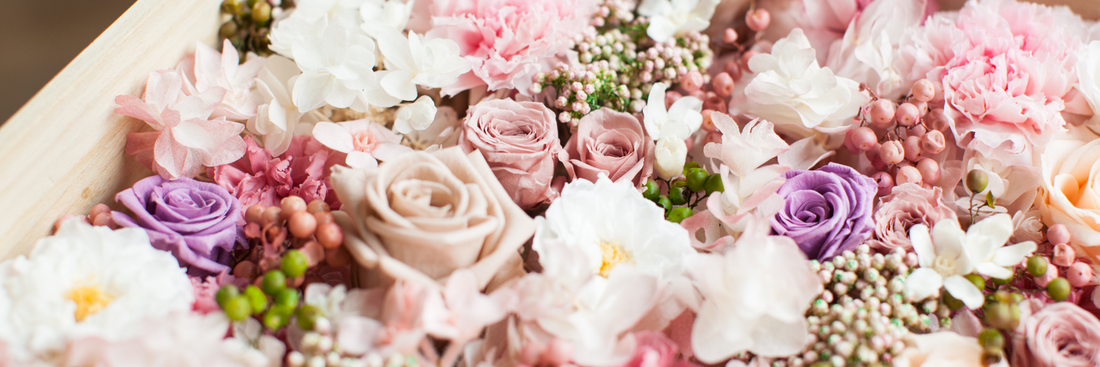The fragrance and appearance of flowers can enhance your memories of a special day. Perhaps you spent months dreaming of and planning your wedding bouquet and flowers. Or maybe you were given a bouquet of favourite blooms by a special person or for a special occasion.
Understanding how to preserve flowers means that you can also preserve these precious memories. And it’s fairly simple to do at home too!
How to preserve flowers

Preserving special occasion or ‘just because’ flowers also preserves the memories associated with those flowers. Even better, preserved flowers can be used to decorate your home or in a range of art and craft projects.
Let’s look at three DIY ways to preserve flowers at home.
1 – Air-dried flowers

- Time needed: Two to three weeks
- Suggested flowers: Flowers with a small calyx work best. This means the petals are tightly held together. Roses, eucalyptus, hydrangea, baby’s breath, lisianthus, salvia and sunflowers are ideal.
- Benefits of air drying: This method for preserving flowers is probably the simplest and most accessible. Air-drying can be used for entire bouquets or individual blooms. Air-drying also helps flowers to retain their shape and colour.
- Method:
- Prepare a dark, dry area that’s well-ventilated.
- Trim excess foliage and leaves from flower stems.
- Trim stems to your desired length. Make sure stems are at least 15cm / 6” long.
- Bind bouquet stems together with string or a rubber band (ignore this step if you’re air-drying individual flowers).
- Hang your bouquet or individual flowers upside down in the dark, dry area.
- To preserve your flowers for as long as possible, spray with unscented hairspray.
- Check on them after two to three weeks. They should be fully dry.
2 – Pressed flowers

- Time needed: At least two weeks
- Equipment: Wooden flower press
- Suggested flowers: Unblemished blooms with a flat bud and single petal layer. Daisies, geraniums, pansies, delphiniums and zinnias work well.
- Benefits of pressed flowers: Pressing flowers is a classic, accessible way to preserve your loved floral memories. It’s an especially hands-on, thoughtful process. And pressed flowers can be used creatively for a range of art projects or pieces. At The Flower Farm, our Sow’n’Sow Handcrafted Flower Presses can also make a perfect gift for a crafty friend or loved one. Each Sow’n’Sow Flower Press is made in Australia and engraved with gorgeous flower and foliage illustrations.
- Method: This particular method of preserving flowers is dear to our heart, so we’ve already written a whole article about pressing flowers! It includes the steps to follow for preserving flowers with a wooden press.
3 – Silica gel preservation (and an oven or microwave)

- Time needed: Up to 10 days for most flowers
- Equipment: Silica gel, oven or microwave. Silica gel is available from various craft or floral supplies shops and online. We don’t recommend any brand of silica gel but suggest googling ‘preserve flowers silica gel Australia’ or ‘flower drying crystals Australia’.
- Suggested flowers: Single blooms such as gerberas, chrysanthemums and roses
- Benefits: Preserving flowers with silica gel can help preserve their colour and structure. The gel draws moisture from the flowers with minimal loss of colour and vibrancy.
- Method:
- Separate flowers from stems. With this method of at-home flower preservation, it’s necessary to remove blooms from their stems.
- Follow the manufacturer’s instructions for combining your flowers with silica gel. This could include layering a container with gel and then placing your blooms on top. More gel would be carefully placed into the folds of the flower.
- Follow the manufacturer’s instructions for how long to leave your flowers and gel in place. This could be up to 10 days. The gel may change colour when it’s ready to be reactivated.
- Placing your flowers in the oven or microwave can speed up the drying process. Times and temperatures will vary. Follow the manufacturer’s instructions (if they recommend oven or microwave drying).
What to do with preserved flowers

Now that you know how to preserve flowers at home, what can you do with them? Well, your beautifully preserved blooms can be used as an art piece in home décor or in a range of art and craft projects.
You might also like to place a dried bouquet inside a shadowbox or under a glass dome, particularly if it represents a special occasion or person. Or you may even take it to be professionally framed for hanging on the wall.
At The Flower Farm, our love for beautiful blooms extends from fresh-picked flowers to preserved flowers. Why not give preserving flowers a try? Our handcrafted wooden flower presses make a lovely gift too.
Our expert team would love to help you choose a fresh seasonal bouquet or talk all things preserving flowers with you.


